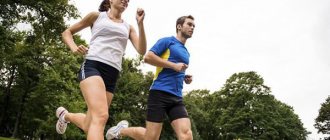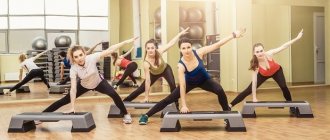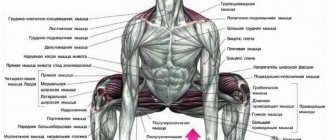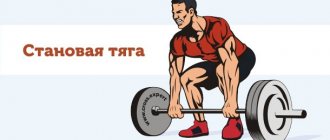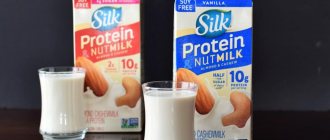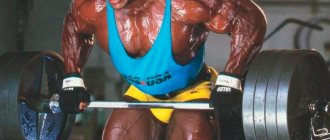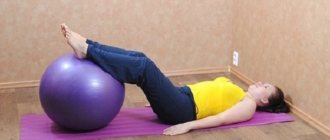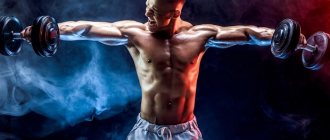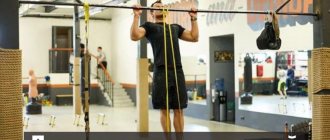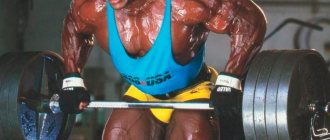Types of strength abilities in physical education
There are 2 types of muscle efforts - absolute and relative. The first group is considered to be able to demonstrate maximum strength characteristics in a relatively short period of time. Absolute muscle tension is expressed in kilograms. Relative strength is taken into account during motor activity associated with body movement.
In physical education it is:
- run;
- jumping;
- riffles;
- crawling;
- climbing and other activities.
Determination of relative strength capabilities is used for dosing and distribution of physical activity. The degree of permissible muscle tension is calculated in the ratio of 1 kg of lifting mass per 1 kg of body weight.
Strength in physical education is a concept that is divided into several types of muscle load:
| Type of effort | Description and examples |
| Isometric | Fastening muscle fibers in a fixed position - on the crossbar and other sports equipment. |
| Power | Pull-ups, cycling |
| Dynamic | They are determined by the movement of the limbs - running, jumping, swimming, throwing sports equipment. |
| Overcoming | Overcoming obstacles, exercises with a hoop and others. |
The development of each type of physical qualities has its own characteristics and patterns. What unites them is only the involvement of motor function by physiological means of the musculoskeletal system and the central nervous system.
Strength abilities
A complex of manifestations in various types of physical activity and activities.
Such characteristics are influenced by numerous internal and external factors, with their contribution changing depending on:
- the current state of the body;
- exercises performed;
- operating conditions;
- age;
- gender identity;
- individual anatomical features.
Internal influencing factors of strength capabilities include muscle characteristics, neurological parameters, and psychological criteria. This also includes the biomechanical characteristics of the body. There are specific strength characteristics, which include speed, agility, and endurance. Their relevance depends on the type of physical exercise.
Speed-strength abilities
They are distinguished by moderate muscular tension, far from the limit of the body's capabilities. They are determined by the situationally required effort and can reach maximum values for a short time.
Such characteristics are important during push-off movements in jumping, final acceleration when throwing an athletic projectile, and spurt when running long or short distances.
The less external resistance an athlete overcomes, the more significant the role of the strength component. With relatively insignificant weighting, the value of the speed component increases.
These abilities include explosive and fast power. The latter is not distinguished by the extremes of muscle effort. Explosive tension is used to achieve maximum muscular activation during a certain period of action or exercise.
Fast Power
The ability to achieve the greatest physical tension per unit of time. In relation to sports disciplines, fast force involves imparting maximum acceleration to one’s own body, an athletic equipment or their individual parts.
This physical characteristic can be represented in the form of realized impulse energy, determined by the duration, the interval at which the peak load is reached, and the slope of the force increase graph. The level of rapid force depends on the muscular stretch-shortening cycle. It differs from speed-strength load in the isometric and concentric values of muscle fiber shortening.
Explosive force
A physical characteristic that reflects the ability to achieve maximum neuromuscular tension in the shortest period of time - usually in the first 0.2-0.3 s. after the start of a sports movement.
Explosive force in combination with the technique of performing the exercise determines the speed capabilities of muscular power. Athletic movements using this ability are called plyometric or ballistic movements.
Strength in physical education is a definition that includes a complex of anatomical, physiological and biochemical factors.
This is especially evident when using explosive voltage, which is provided by:
- impulse frequency in the initial phase of contractile movement of muscle fibers;
- motor neuron signal synchronization, called neural coordination;
- indicators of muscular ability to rapidly contract;
- level of hypertrophy of fast-twitch muscle structures.
The development of explosive strength is necessary in sports disciplines that require sudden movements of increased power. These include shot throwing, sprinting, martial arts, and some team sports.
Strength endurance
The ability to implement relatively high impulse muscle tension for a given period of time during loading movement. Strength endurance is characterized by a non-significant difference between the maximum possible effort and what is actually achieved in a certain time interval.
This is the body's ability to resist fatigue when the body functions at power close to maximum. The duration of endurance is determined in the range of 3-4 minutes. and is realized through anaerobic-glycolytic energy conservation.
Strength endurance is important when working with heavy weights of sports equipment or athletic equipment. It is characterized by minor muscle contractions. If the mass is relatively small, such endurance is called general.
Dynamic
The ability of muscle structures to perform heavy sports work of moderate intensity over a significant time distance. Dynamic endurance is directly related to the strength characteristics of the body.
For its development, weighting agents of 50% of the maximum value for a particular organism are intended. Such exercises are performed at a moderate rhythm. You need to work until you get very tired. Between sets, take even time breaks for recovery.
Static
It is considered typical for sports activities associated with prolonged retention of maximum or moderate muscle tension necessary to maintain a certain body position in space.
Static endurance is developed with the help of isometric exercises, the duration of which is limited by the phase of compensatory fatigue. The loads are 82-86% of the maximum possible.
A variety of techniques allow you to effectively work on any muscle group. The starting position and joint bending angles should be such that the target muscle structures are involved in the work.
Power Agility
Accurate differentiation of muscle tensions of various magnitudes in non-standard situations and combined modes of sports activity. The concept is directly related to the speed of the reaction.
Strength agility is especially evident at the physiological level with a variable rhythm of functioning of different muscle groups. It is in demand in volleyball, football, and hockey.
What are the physical qualities of an athlete
Physical qualities are innate (genetically inherited) morphofunctional qualities, thanks to which physical (materially expressed) human activity is possible, which receives its full manifestation in purposeful motor activity. The main physical qualities include muscle strength, speed, endurance, flexibility and agility.
5 physical qualities of an athlete
In sports, it is important to pay attention to the development of basic physical qualities: speed, strength, agility, endurance and flexibility. For a better understanding, a definition of each quality is provided below.
Speed is a person’s ability to perform a motor action in a minimum amount of time. Speed, which requires mastery of basic movements, is best developed in outdoor games and relay races.
Strength is a person’s ability to overcome external resistance or resist it through muscular effort. Strength is developed in general developmental exercises with light weights (a medicine ball, for example) and in pair exercises where you need to overcome reasonable resistance from your partner.
Dexterity is a set of human abilities that allows you to master new movements and rearrange them in accordance with a suddenly changing environment. This complex quality, requiring coordination and precision of movements, develops in the main types of activity - running, working with objects and when performing exercises in changing conditions - sports games and relay races.
Endurance is the body's ability to resist fatigue during prolonged or intense physical activity. Developing endurance requires more repetitions of the same movements. It is important not to overdo it, otherwise the child will lose interest in practice.
Flexibility is the ability of the human body to achieve the highest range of motion in the desired direction. Flexibility develops when performing movements with a greater amplitude than in everyday life, but within anatomically acceptable limits. At the same time, balance develops when performing exercises with a decrease in the area of support (for example, standing on tiptoes, on one leg) and on objects raised from the ground (bench, hemispheres).
Motor abilities
In modern literature, the terms “physical qualities” and “physical (motor) abilities” are distinguished.
Motor abilities are individual characteristics that determine the level of a person’s motor capabilities.
The basis of a person’s motor abilities is physical qualities, and the form of manifestation is motor abilities and skills.
Motor abilities include:
- power
- expressways
- speed-power
- motor coordination abilities
- general and specific endurance.
It must be remembered that when talking about the development of muscle strength or speed, this should be understood as the process of developing the corresponding strength or speed abilities.
Each person's motor abilities are developed differently. The basis for the different development of abilities is the hierarchy of different congenital (hereditary) anatomical and physiological inclinations:
- anatomical and morphological features of the brain and nervous system (properties of nervous processes - strength, mobility, balance, individual variations in the structure of the cortex, the degree of functional maturity of its individual areas, etc.);
- physiological (features of the cardiovascular and respiratory systems - maximum oxygen consumption, indicators of peripheral circulation, etc.);
- biological (features of biological oxidation, endocrine regulation, metabolism, energy of muscle contraction, etc.);
- bodily (length of the body and limbs, body weight, mass of muscle and fat tissue, etc.);
- chromosomal (gene).
The development of motor abilities is also influenced by psychodynamic inclinations (properties of psychodynamic processes, temperament, character, features of regulation and self-regulation of mental states, etc.).
A person’s abilities are judged not only by his achievements in the process of learning or performing any motor activity, but also by how quickly and easily he acquires these skills.
Abilities manifest themselves and develop in the process of performing activities, but this is always the result of joint actions of hereditary and environmental factors.
To develop motor abilities, it is necessary to create certain conditions for activity, using appropriate physical exercises for speed, strength, etc. However, the effect of training these abilities also depends on the individual norm of reaction to external loads.
What does physical strength depend on?
Muscle power is influenced to varying degrees by a variety of factors.
Among the main ones are:
- Muscle volume. Muscular hypertrophy of myofibrillar and sarcoplasmic tissues. Muscle strength is somewhat correlated with muscle size, but not linearly.
- Innervation parameters. The more neurons the muscle fibers contain, the better their contractility, which largely determines strength indicators.
- Thickness and flexibility of tendons. One of the most important factors of physical strength. The indicator of muscle power and endurance rests on the ability of the tendons to withstand a given load.
- The ratio of fast-twitch muscle fibers to slow-twitch muscle fibers. The former are conventionally called white, the latter – red. Fast-twitch muscles are better suited to explosive and maximal short-term loads. Slow muscles contain more blood vessels and intracellular mitochondria, so they are designed for work that requires endurance.
- Elasticity of muscle fibers. Muscles work in contraction-extension cycles. The more significant the difference between these phases, the greater the strength the muscle structures are able to develop.
- Tendon attachment points. Muscles work according to the physical principle of leverage. The closer the tendon attachment point is to the axis of rotation of the articular joint, the greater the force the muscle develops.
The strength characteristics of muscles are influenced by hormonal factors, the number of muscle fibers, and the degree of psycho-emotional arousal. Therefore, they depend on a large number of constant and variable parameters.
Biomechanical factors
Strength in physical education largely depends on the biomechanical properties of skeletal muscles. These are characteristics that come into play under appropriate loads experienced by muscle groups.
These properties include:
- contractility;
- fiber stiffness;
- connective tissue viscosity;
- strength of muscle structures and tendons;
- relaxation opportunities.
Muscle contractility is the ability of fibers to decrease in size when innervated. Due to such excitation, traction power arises. During the biomechanical process, the length of the muscle filaments remains unchanged.
The stiffness of muscle fibers is a parameter that reflects their resistance to deformation loads. The resulting tension is disproportionate to the lengthening of the muscle fiber. Another important biomechanical factor in strength characteristics is muscle viscosity.
It characterizes the ability of muscle structures to resist non-inertial movements of one section of the fiber relative to another. Muscular strength is the amount of tensile force at which it breaks.
For myofibrils, the maximum is determined at the level of 16-25 KPa, for fascia - 14 KPa. The relaxation property of muscles, related to the biomechanical factors of strength, is a decrease in traction over time while the length of the fibers remains unchanged.
Factors related to the central nervous system
The main one is the innervation of muscle structures. In a person with weak physical development, up to 50% of the muscles are involved in this process, and in a trained person, the figure can increase to 90%. The central nervous system regulates reflex activity, contractile function and many others. Muscle development and strength characteristics largely depend on the functioning of the central nervous system.
Muscular factors
This includes the proportion between fast and slow fibers. This anatomical factor is assigned to the body from birth and cannot be changed. Both types of muscles can be strengthened, developed and trained.
The next most important muscle factor is the number of fibers. Increasing the amount of muscle tissue without the use of advances in sports pharmacology is not possible. On its own, the body hyperplasias no more than 3-5% of the muscles.
Strength in physical education is a concept that is influenced by the elasticity of muscle fibers. As the amplitude of muscle contractions increases, the power value increases. Muscular elasticity is developed with special exercises.
Psychological factors
They are directly related to hormonal secretion. The ability to release large volumes of norepinephrine into the blood, which increases physical performance and endurance, depends on the psychological state.
Physical quality FAST
Speed is a complex of properties that directly determine the speed characteristics of movement, as well as the time of motor reaction. A person’s ability to perform motor actions in a minimum period of time for given conditions.
In rock climbing, this physical quality plays a decisive role in the “speed” discipline.
Psychological characteristics of speed
From a psychological point of view, speed is the ability to control the temporary signs of movement, a reflection in the athlete’s mind of the duration, tempo and rhythm of movement.
The speed of movements is determined, first of all, by the corresponding activity of the cerebral cortex, the mobility of nervous processes that cause contraction, tension and relaxation of the muscles that direct and coordinate the action of the athlete.
The key to speed depends on three main components:
- Mobility of nervous processes : only with a very rapid change of excitation and inhibition and corresponding regulation of the neuromuscular system can a high frequency of movements be achieved with optimal application of force; the duration of the perception process, i.e., the transmission of information and the beginning of a response, forms the basis for the speed of the motor reaction.
- Tension of will - achieving the maximum possible speed depends to a certain extent on the conscious act of applying effort to oneself.
- Coordination central nervous factors to a certain extent influence the frequency of movements. But no less dependent on them is the speed of an individual movement. Coordination (central nervous) factors include a set of central nervous coordination mechanisms for controlling the muscular apparatus and mechanisms of intramuscular and intermuscular coordination. With the help of coordination factors, in particular, the contractile forces of muscles (muscle groups) corresponding to the peak speed of movement (action) are regulated.
Forms of manifestation of speed
The indicator characterizing speed as quality is determined by:
- motor reaction time (the minimum time required to initiate an action in response to a specific stimulus). This is the time spent by an athlete to initiate an action in response to a certain stimulus known to him, for example, a start sound signal (a shot from a starting pistol, a referee's whistle). In this case, the latent time of the motor reaction will be the time spent by the athlete perceiving the sound signal, processing the information received, and transmitting the impulse to action as a response to the stimulus. The end of this process is considered to be the moment from which the athlete’s physical activity begins.
- the speed of an individual movement is characterized by the mental organization of a single action.
- tempo (frequency of identical movements per unit of time).
If a person’s walking consists of many repeated movements (steps), then one step is a separate movement. The speed of one step is the speed of a single movement . The speed of steps is, respectively, the frequency of movements .
These three forms of manifestation of speed are independent of each other. Each of them has its own characteristics, which exist in time parameters.
Means and methods for developing speed of movement
Methods for developing speed:
– a method of repeated repetition of speed exercises with maximum and near-limit intensity (3-6 exercises are performed in a series, 2 series are performed in one session. If in repeated attempts the speed decreases, then the work on developing speed ends, because when this begins to develop endurance, not speed);
– game method (provides an opportunity for the comprehensive development of speed qualities, since there is an impact on the speed of motor reaction, speed of movements and other actions associated with operational thinking. The high emotional background inherent in games and collective interactions contribute to the manifestation of speed capabilities).
The means for developing speed can be athletics, sports games, etc.
Methods for developing strength abilities in physical education
The training process is accompanied by regulatory and structural changes in the body and metabolic transformations. The degree of severity of adaptation perturbations is determined by the techniques used, the frequency of training and the sports program.
Strength abilities are actively developed with maximum muscle tension. Methodically, the loads are increased in various ways depending on the individual characteristics of the athlete’s body and the anatomical structure of the target muscles.
Maximum Effort Method
It is based on the inclusion in the training program of exercises with different weights of weighting devices. Perform a precisely calculated number of sets of repetition cycles.
They are determined individually based on the maximum resistance of muscle fibers. When the weight of the weights reaches 100% of the body’s capabilities, do 1-2, maximum 3 approaches. The intervals between them are no more than 4 minutes. At near-maximum loads, when the weight of sports loads reaches 90-95% of the maximum, the number of cycles should be 5-6, and approaches - 2-5. Rest periods can be increased to 6 minutes.
The pace of work is chosen arbitrarily, and the speed of training movements varies from slow to intense. When training athletes, various versions of the maximum effort method are used. They are aimed at developing extreme dynamic strength characteristics without noticeably increasing muscle volume and improving the ability to concentrate on hard sports work.
The power indicators of muscle fibers increase due to the improvement of internal and intermuscular coordination. During such training, the mechanism of ATP synthesis, an enzyme that plays a leading role in protein metabolism, is activated. This leads to increased muscle strength.
Disadvantages of the ultimate effort method:
- difficulty in self-control of exercise technique;
- increased risk of injury;
- possibility of muscle strain;
- problematic use for children and novice athletes.
It is recommended to use strength training with maximum loads no more than 3 times a week.
Repeated Effort Method
Based on repeated overcoming of unlimited external resistance. Approaches are performed without breaks. Each one does 15-20 cycles. Perform 2-6 series in one workout.
Each set contains 2-4 approaches. The rest pause between series should not exceed 5 minutes. The indicator of external resistance of sports equipment or equipment is fixed at the level of 40-80% of the maximum physical capabilities of the body.
Exercises are performed at a low pace. Depending on the number of series, number of cycles and approaches, endurance develops or muscle mass increases and strength characteristics increase.
Significant volumes of muscular work with an unlimited weight of weights enhance metabolic-trophic reactions in muscle fibers and functional systems, which causes hypertrophy of muscle fibers and stimulates the development of strength characteristics.
Impact method
Used to increase shock-absorbing properties and explosive strength of various muscle groups. To work the muscles of the lower extremities, push-off exercises, high jumps and long jumps are used.
It is recommended to perform 4 sets of 10 repetitions each. Rest pauses between series are no more than 5 minutes. The impact method is used to strengthen and develop any muscle groups. Use your own weight or weights.
Methods for developing explosive strength and muscle reactivity
The techniques involve the use of weights, jumping exercises, and shock mode of muscle work. Explosive strength and reactive abilities of the neuromuscular mechanism are developed using the repeated effort method or plyometric method.
Maximum load techniques are suitable for professional athletes. Explosive strength of muscle fibers is necessary for the development of jumping ability in track and field athletes. It is developed through repeated repulsions.
They use comprehensive training programs that include a wide range of means and techniques for improving explosive strength characteristics, increasing the elasticity and firmness of muscle fibers.
Method for developing dynamic (speed) strength
Necessary for fast movements under conditions of low external resistance. Speed characteristics are improved with the help of jumping exercises with weights. Weights are used in different weights and options depending on the goal. The maximum permissible weight of sports cargo is 70% of the maximum physical capabilities.
Strength in physical education is a definition that involves the use of different techniques for developing the same muscle group. The best results in increasing speed characteristics are achieved by isokinetic exercises.
Methods for developing strength endurance
Training the ability to demonstrate maximum performance of muscle fibers over a long period of time is of great importance in the preparation of professional athletes.
The development of strength endurance, also aimed at improving motor qualities, requires an integrated approach. During such training, the autonomic functions of the nervous system are activated. The main technique for developing strength endurance is the method of repeated loads. Complexes of exercises are used that have a selective effect on various factors of strength characteristics.
Isometric method
It is based on short-term maximum tension of muscle structures without changing the length of the tissue. The exercises performed serve as an additional means of developing strength capabilities. Muscle tension is increased to the maximum value smoothly and maintained for several seconds. The isometric method involves positions that allow maximum tension of the target muscle group.
Literature
- Vaitsekhovsky S. M. Coach's book. – M.: Physical culture and sport, 1971. – 312 p.
- Verkhoshansky Yu. V. Fundamentals of special physical training of athletes. – M.: Physical culture and sport, 1988. – 331 p.
- Dvorkin L. S. Strength martial arts. Athleticism, bodybuilding, powerlifting, kettlebell lifting. – M., 2001. – 223 p.
- Dvorkin L. S., Khabarov A. A., Evtushenko S. F. Methods of strength training for schoolchildren 13–15 years old, taking into account their somatic maturity // Theory and practice of physical culture. 1999, no. 3, p. 34–35.
- Dvorkin L. S., Khabarov A. A., Lysenko V. V. Experience of basic strength training for schoolchildren aged 12–14 years of various strength specialization // Physical culture and sport, 2000, No. 1, p. 34–38.
- Dvorkin L. S. Young weightlifter. – M.: Physical culture and sport, 1982. – 160 p.
- Zatsiorskny V. M. Physical qualities of an athlete. – M., Physical culture and sport, 1970. – 212 p.
- Korenberg V.B. The problem of physical and motor qualities // Theory and practice of physical culture, 1996, No. 7, p. 2-5.
- Kots Ya. M. Physiology of muscle activity. Educational for the institute of physics. cult. M., 1982. – 415 p.
- Marchenko V.V., Dvorkin L.S., Rogozyan V.N. Analysis of the strength training of a weightlifter in several macrocycles // Theory and practice of physical culture. 1998, no. 8, p. 18–22.
- Matveev L.P. Fundamentals of sports training. – M.: Physical culture and sport, 1977. – 271 p.
- Matveev L.P. Theory and methodology of physical culture. Textbook for the Institute of Physics. culture. –– M.: Physical culture and sport, 1991. – 543 p.
- Ozolin N. G. Modern system of sports training. – M., Physical culture and sport, 1970. – 356 p.
- Theory and methodology of physical education (under the general editorship of L.P. Matveev and A.D. Novikov). M., Physical culture and sport, 1976. – 423 p.
- Filin V.P. Education of physical qualities in young athletes. – M.: Physical culture and sport, 1974. – 232 p.
- Hatfield F. K. A Comprehensive Guide to Strength Development. Per. from English – Vladivostok: Publishing house. “Vostok”, 1996. – 390 p.
Diploma work “Methodology for developing the strength abilities of young weightlifters using exercise machines” (see in the Library).
Limiting loads to develop strength and maximum strength endurance
The dosage of muscle tension depends on the tasks and the desired result. Exercises with external resistance less than 50% of the body's maximum capacity have virtually no effect on muscle hypertrophy.
They allow you to develop strength endurance at high intensity performance. This characteristic is specific for different values of external resistance and is calculated individually. Progress in strength capabilities starts from 75-80% with a gradual increase in loads.
Physical quality AGILITY
Dexterity is the ability to solve a variety of motor tasks quickly, accurately, economically, and resourcefully.
This is a person’s ability to quickly master new movements and quickly rearrange motor activity in accordance with the requirements of a changing environment. In this case, the object of cognition is movements and actions performed with the utmost precision of spatial, temporal and force parameters.
Among physical qualities, agility occupies a special position. It manifests itself only in combination with other physical qualities. Agility is a specific quality that manifests itself differently in different sports. A person may have a high degree of dexterity in gymnastics, but not enough for sports games. Dexterity is closely related to motor skills and is therefore the most complex.
Dexterity is:
- firstly, the ability to master complex motor coordination ;
- secondly, sports movements and their improvement ;
- thirdly, in accordance with the changing situation, quickly and rationally restructure your actions .
Agility Stats
As is known, V.M. Zatsiorsky offers several criteria for agility that make it possible to quantify this ability:
- Coordination difficulty of a motor task.
- Accuracy of execution (correspondence of spatial, temporal and power characteristics to the motor task).
- Mastery time (training time required for an athlete to master or correct the required precision of a movement).
In sports characterized by rapid changes in activity conditions and high variability of actions, it is important to reduce the time between the signal to perform and the beginning of the movement. In a rapidly changing environment, great agility is required to respond quickly, expediently and consistently. Here, a measure of dexterity can be the ability to quickly adapt ( resourcefulness ).
Agility is an important prerequisite for the development and improvement of sports technique and is therefore of paramount importance in sports that place high demands on coordination of movements. It plays a big role in those sports that require the ability to adapt to rapidly changing situations in competition (sports games). Such dexterity is manifested in the appropriate selection of previously acquired skills and conscious correction of movements.
Dexterity is also needed during reactive movements, when an athlete has to reflexively (instantly) restore disturbed balance (in the event of a collision, slipping, etc.).
In sports psychology it is customary to distinguish between:
- general dexterity (manifested in various areas of sports activity);
- special dexterity (the ability to master and variably use sports equipment).
Prerequisites for the development of dexterity
Dexterity, as noted above, can only manifest itself in combination with other physical qualities. This is one of the main prerequisites for the development of agility - human physical abilities .
Another prerequisite that influences the development of agility is range of motion . Each movement being studied is partially based on old, already developed coordination combinations, which together with new ones form a new skill. The more subtle, precise and varied the activity of the motor apparatus was, the greater the athlete’s stock of conditioned reflex connections, the greater the number of motor skills he masters, the easier it is to assimilate new forms of movements, the better he adapts to existing and changing conditions of activity - the greater his dexterity.
The activity of analyzers is the third basic prerequisite for the development of dexterity. Along with the certain role of previously acquired motor experience, the processing of current information (visual, auditory, kinesthetic, tactile and vestibular signals) plays a great role in the development and manifestation of dexterity. The relevant current information is perceived using analyzers. The total data from all analyzers makes it possible to understand the movement process in more detail, providing more accurate analysis of it in order to quickly master it and, if necessary, rebuild it.
Everything shows how great the dependence of dexterity is on the functional capabilities of the central nervous system. Formation of dexterity in sports involves developing the following abilities:
- quickly master complex motor actions;
- rebuild motor activity in accordance with the requirements of a changing situation;
- clearly perceive spatial, temporal and force parameters of movement.
Means and methods for developing dexterity
Typically, repetition and play methods are used to develop dexterity . Rest intervals should ensure sufficient complete recovery of the body.
The most common means of developing dexterity are acrobatic exercises, sports and outdoor games. In the process of developing dexterity, a variety of methodological techniques are used:
- performing familiar exercises from unusual starting positions (throwing a basketball from a sitting position);
- mirror execution of exercises;
- complicating the conditions for performing regular exercises;
- changing the speed and tempo of movements;
- changing the spatial boundaries of the exercises (reducing the size of the field).
Development of strength abilities
Special sets of exercises and techniques have been developed for children and adults, men and women, beginner athletes and professional athletes. The use of a specific method of physical development depends on the target muscle group.
Exercises with the weight of external objects
Strength in physical education is a concept that implies the possibility of working out muscle fibers using sports equipment or the weight of one’s own body. The first option provides a precisely specified voltage by varying the mass of weighting materials. In this capacity, they use a barbell, weights, dumbbells, and other equipment.
According to the degree of selectivity of impact on muscle structures, exercises with external resistance of weights are divided into:
- local;
- regional;
- total.
There are many techniques for doing them.
Bodyweight exercises
Such workouts are functional and universal. They allow you to maintain good physical shape without access to exercise equipment and are suitable for beginner athletes. Any muscle group can be worked out efficiently without sports equipment.
Bodyweight exercises include push-ups, pull-ups, and squats. The load can be changed in intensity, strength and vector. This is ensured by different types of hand placement, range of movements, number of cycles and approaches.
Exercises using training devices
Such techniques can be basic or isolated.
There are a huge number of exercises on simulators for:
- development of strength endurance;
- building muscle volume;
- increasing the elasticity of muscle fibers.
Deadlifts, bent-over barbell presses, and many others are popular. A variety of weights allows you to vary the external resistance. You can do push-ups on the machines, which strengthen and develop your pectoral muscles.
Jerk-braking exercises
Similar training complexes can be performed with weights or your own weight. Exercises of the jerk-braking type represent a continuous change of fast movements with the contraction of some muscle groups and the lengthening of others, acting as their antagonists.
These include shuttle running over short distances, in zigzags, at an angle, rapid jerks with acceleration, and others. These are specialized training sets that increase the elasticity and firmness of muscle fibers.
Apply:
- sharp turns;
- Bends with a barbell;
- moving weights.
Isometric exercises
When performing such techniques, the muscle structures do not contract, but only tense. There is no movement. Muscle groups are exposed to maximum short-term loads.
Such exercises develop strength and endurance. In physical education, static techniques are used for the arms, legs, and abdominal muscles. With the help of such complexes, the latissimus dorsi and pectoral muscles are developed. Isometric exercises are techniques that allow you to improve your physical fitness without equipment.
How to increase strength, and how to increase muscle size
If you are only interested in strength, train with heavy weights and small ones. Differential Effects of Heavy Versus Moderate Loads on Measures of Strength and Hypertrophy in Resistance-Trained Men, Effects of different volume-equated resistance training loading strategies on muscular adaptations in well-trained men. number of repetitions.
Two to five repetitions per set provide maximum strength gains.
Choose multi-joint movements, ideally ones that require you to be strong. That is, if you want to set a record in a squat, do squats; if you have to carry or push weights for work, do it in the gym: flip a tire, push a sled, do a farmer’s walk with weights.
Your body learns to perform the movement as efficiently as possible: tighten fewer muscle fibers, relax antagonist muscles, and use synergists. This will give a much better effect than performing isolated exercises on the same muscle groups.
If you are not interested in strength and only need big muscles, follow Differential Effects of Heavy Versus Moderate Loads on Measures of Strength and Hypertrophy in Resistance-Trained Men, The effect of training volume and intensity on improvements in muscular strength and size in resistance-trained men . 8-12 reps per set and select the weight so that you can do them all with maximum effort.
Choose different exercises and try new methods of performing already familiar movements: a different machine, range of motion in a joint, bend angle. All this stimulates muscle growth.
Physical quality FLEXIBILITY
Flexibility is the mobility in the joints, allowing you to perform a variety of movements with a large amplitude. Flexibility is an elementary condition for high-quality performance of movements. This is the property of elastic stretchability of bodily structures (muscular and connective), which determines the limits of the amplitude of movement of body parts. Insufficiently developed joint mobility leads to:
- inability to acquire certain motor skills;
- slowdown in the rate of assimilation and improvement of motor abilities;
- occurrence of damage;
- delays in the development of strength, speed, endurance and agility;
- limited range of motion;
- reduction in the quality of movement control.
Flexibility Characteristics
The degree of mobility in the joints is determined primarily by the shape of the joints and the correspondence between the articulating surfaces. The extensibility of the articular ligaments, tendons and the strength of the muscles passing around a particular joint determines what amplitude of action an athlete can use. The elasticity (stretchability) of ligaments can be increased through systematic exercise. However, due to the fact that the ligamentous apparatus must perform a protective function, such an increase is possible only to a certain extent. An athlete's flexibility is limited primarily by muscle elasticity. The essence of this limitation is as follows: in various exercises, contraction of certain muscles is accompanied by stretching of their antagonists. When moving with maximum amplitude, mobility in the joints depends on the ability of the antagonists to stretch sufficiently, and it should be remembered that there is a certain limit to their ability to return to the starting position, so special exercises when training flexibility must be combined with strength exercises. An athlete's strength is an important component when training to develop flexibility. Often, due to insufficient muscle strength, an athlete is unable to achieve the required range of motion. In humans, there are two forms of flexibility:
- active – the magnitude of the amplitude of movements when performing an exercise independently, due to one’s own muscle efforts. Indicators of active flexibility are characterized not only by the ability of antagonist muscles to stretch, but also by the strength of the muscles performing the movement.
- passive – the maximum range of motion achieved under the influence of external forces (partner, weight).
Flexibility is determined by the following parameters:
- elastic properties of ligaments, joints, muscles;
- joint structure;
- muscle strength characteristics;
- central nervous regulation.
Because of this, real indicators of flexibility depend on a person’s ability to combine voluntary relaxation of the stretched muscles with tension of the muscles producing the movement. In addition, it should be noted that flexibility has a fairly strong relationship with other physical qualities. Development of flexibility is impossible without corresponding development of muscle strength. At the same time, greater mobility in the joints helps to increase accuracy, coordination and speed of motor action. An athlete with more joint mobility can perform movements with greater strength, expressiveness, and ease.
Tools and methods for developing flexibility
One of the most accepted methods of developing flexibility is the method of repeated stretching. This method is based on the ability of muscles to stretch more with repeated repetitions. The means of developing flexibility are: repeated springing movements, active free movements with a gradual increase in amplitude, passive exercises performed with the help of a partner, etc. You should always remember that stretching exercises or exercises with a large amplitude of movement should be done after a good warm-up and should not cause severe pain.
Which increases faster: volume or strength?
Many people mistakenly believe that muscle volume and strength increase proportionally. This is wrong. Muscle fibers increase faster in cross-sectional area than in strength. It turns out that muscles increase faster in volume than in strength. Increasing muscle volume by 2 times gives an increase in strength by only 41%.
When compared to people who lift weights, their muscle strength is 61% lower than that of lifters.
The number of weak and strong fibers varies from person to person. The strength of muscles of the same volume can differ by 3 times.

